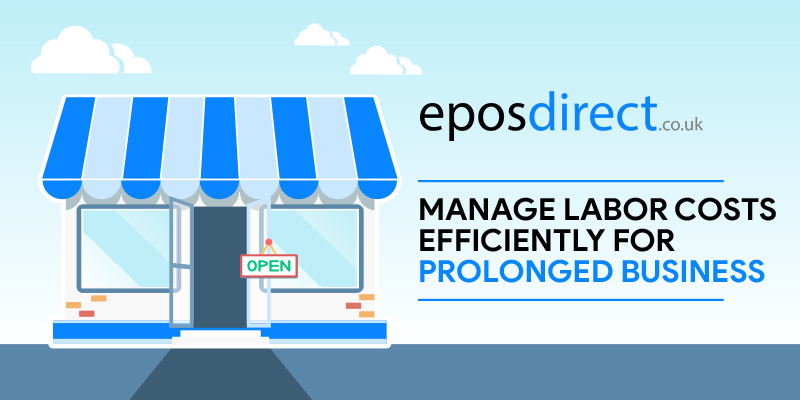We use cookies to make your experience better.
To comply with the new e-Privacy directive, you agree to the privacy policy and our use of cookies
How to Manage Labor Costs Efficiently in Your Restaurant
Restaurant labor costs are usually the most expensive aspect of running a restaurant. Labor costs are typically kept between 20percentage and 30percentage of gross revenue by restaurateurs. Full-service restaurants with white tablecloth will have a higher labor costs percentage than casual dining restaurants. This is because they employ more people to provide a higher quality of service.
So, how do you keep restaurant labor costs under control? There is no one-size fits all solution to managing restaurant labor costs. Each bar, restaurant and coffee shop is unique, so each place will have a unique situation with regard to restaurant labor cost management. You can begin by tracking staffing through your restaurant POS system, but everything after that will depend on your restaurant’s specific needs.
What is Labor Cost?
The percentage of a restaurant’s expenses that go toward recruiting and retaining employees is referred to as labor cost. Although the ideal ratio of revenue allocated to salaries and wages will vary depending on your business type, it is prudent to keep labor costs under control. In the restaurant industry, a common labor cost target of 35% is widely accepted.
Fast-food chains can achieve labor costs as low as 25%, whereas table service restaurants are more likely to be in the 30-40% range. This is entirely dependent on the menu and service style. The restaurant industry’s food and beverage expenses generally range between 28 and 35 per cent.
This percentage can be automatically calculated if your POS system is integrated with employee management software.
Rethink your Schedule Regularly
While it may seem easier to keep employees on a schedule for months, it is a smart idea to regularly reevaluate your work time to avoid overbooking employees. Your restaurant's traffic will vary from day to day, week after week, and monthly. Although employees sometimes acknowledge a consistent schedule, it is not ideal for your company.
You're wasting time and money on labor if your wait staff outweighs customers during certain shifts. Your employees will also appreciate more flexibility and control of their work schedules, which could help you save money on high turnover.
Designate Tasks for Every Payroll Log
It may be beneficial for you to be aware of how your employees spend their time. Even a seemingly simple task like putting away inventory may prove to be more difficult than you think. It may help you to determine which processes to automate by having your staff monitor their time in their payroll log. This can tell you when more servers are needed during peak hours. Overall, keeping track of specific tasks will assist you in determining whether your employees are spending their time as productively as possible and allocating staff in a way that minimizes labor costs.
Calculate your Staff Turnover
A high turnover rate can significantly reduce your labor costs. Furthermore, the cost of recruiting and training new employees can easily eat into your labor force's efficiency over time.
It's a particular issue in the hospitality industry. For example, in 2019, the average employee turnover rate in the UK hospitality sector was 30%, which was twice the national average!
Taking measures to ensure employee satisfaction is a wise way to improve as a manager while also focusing on the result.
How to Calculate Staff Turnover
Knowing how to calculate your employee turnover rate allows you to better track and reduce staff turnover. Assume you want to calculate the employee turnover rate over six months.
First, determine your average employee count. You had thirty employees at the start of the period; six months later, your staff had shrunk to eighteen. To determine the average number of employees, perform the following calculation: Determine Employee Turnover Rate.
Average employee count = (number of employees at the start of the period) + (number of employees at the end of the period) / 2
Employee turnover rate = (employees that left) / (average number of employee) x 100
Schedule Based on Revenue (and climate) Predictions
Sure, it's tempting to keep the same number of employees on hand for every shift all year. The true need for workers in your organization recognition, on the other hand, may vary throughout the year. It's useful to have a sense of when your busiest seasons are.
You can plan the right staffing levels at different points in time using employee scheduling solutions like Pay day. E.g., if you have a large outdoor patio, scheduling fewer employees when the weather forecast predicts rain makes sense. Alternatively, if a special event occurs in your area, schedule more employees or keep some on-call to accommodate the expected raise in foot traffic.
Play to your Employee’s Competency
After, you have been analyzing your labor costs for a while. Your employees’ pros and cons will likely become clear. One server might be a master at managing your busy nights, while another may have a knack for getting customers to order more. Recognizing and rewarding these talents and utilizing them to your advantage will reduce labor costs, as well as make employees feel valued.
Automate the Scheduling Process
The days of time clocks and paper schedules are long gone, and managing employee schedules does not have to consume a large portion of your time. You can use free shift planning software like Home base to save time and gain real-time insight into your labor costs, especially if integrated directly into your POS system.
You can do a lot to run a more efficient restaurant business, from weather forecasts to your employees’ strengths. Keeping the above suggestions in mind will assist you in managing your staff and lowering your labor costs!
In Conclusion
Labor is a major restaurant expense that can be difficult to manage. You must not only run a restaurant and keep track of other costs, but you must also deal with minimum wage increases.
The great news is that you can succeed this challenge and reclaim control by understanding your labor costs, knowing how to calculate them, tracking your labor cost percentage, and, most importantly, implementing the appropriate strategies, such as investing in the right employee scheduling tool.










